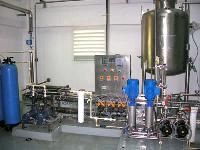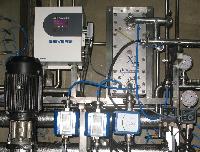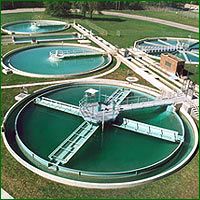
ultra filtration
We offer Ultra filtration. Ultrafiltration (UF) is a membrane filtration in which hydrostatic pressure forces a liquid against a semipermeable membrane. Suspended solids and solutes of high molecular weight are retained, while water and low molecular weight solutes pass through the membrane. Ultrafiltration is not fundamentally different from reverse osmosis, microfiltration or nanofiltration, except in terms of the size of the molecules it retains. UF's main attraction is its ability to purify, separate, and concentrate target macromolecules in continuous systems. UF does this by pressurizing the solution flow. The solvent and other dissolved components that pass through the membrane are known as permeate. The components that do not pass through are known as retentate. Depending on the Molecular Weight Cut Off (MWCO) of the membrane used, macromolecules may be purified, separated, or concentrated in either fraction.
...more
Sand Filter
We offer sand filter.sand filtration is frequently used and very robust method to remove suspended solids from water. The filtration medium consists of a multiple layer of high silica sand with a variety in size and specific gravity. sand filters can be supplied in different sizes and materials both hand operated or fully automatically. A special application of a sand filter is the removal of iron in surface and ground or well water. An iron removal installation consists of a aeration to oxidise and precipitate the iron and manganese, followed by removal of the precipitated particles with the sand filter. During service water enters from the top, travels through the filtering media & goes out from the bottom. The suspended solids in the water get trapped in the filter & we get clean clear water at the outlet. This accumulated dirt (suspended solids) needs to be removed otherwise the filter will get choked & will result in less treatment flow, damage to the filter, damage to the pump, etc. The cleaning operation of the filter is called backwash. This backwash operation needs to done once the differential pressure across the filter reaches 0.8 kgcm2 or 24 hours of service cycle whichever is earlier.
...more
Commercial Reverse Osmosis Unit
We are offering reverse osmosis. R.o is a membrane process that acts as a filter to remove up to 95 - 99 % of all dissolved minerals, 95 - 97 % of most dissolved organics, and more than 98 % of biological and colloidal matter from water the water is passed over a membrane under pressure. Depending on raw water quality a larger or smaller part of water goes through membrane, leaving most of the dissolved solids behind. These solids and leftover water (reject) leaves membrane surface and is piped to drain. The water which goes through membrane and gets purified is called permeate. The equipment which accomplishes the process is called a reverse osmosis (r.o) unit
Capacity : 100-1000L
Material : Mild Steel, Stainless Steel
Power : 0-3kw
Power Source : Electric
Industrial Use : Commercial
Voltage : 220V
Control Type : Semi Automatic
...more
Electro-de-ionization
We offer Electro de ionization.The EDI design combines two well-established water purification technologies electrodialysis and ion-exchange resin deionization. Through this revolutionary technique, dissolved salts can be removed with low energy cost and without the need for chemical regeneration; the result is high-quality pure water of multi-M_.cm resistivity which can be produced continuously at substantial flow rates. EDI removes ions from water by forcing them out of the feed stream into adjacent streams via an electric potential. The resins operate in steady state; they act not as an ion reservoir but as an ion conduit.
...more
Coagulation Flocculation
We offer Coagulation Flocculation. We classify water impurities in three categories: suspended solids, colloidal particles (less than 1 micron) and dissolved substances (less than several nanometers). The coagulation-flocculation processes facilitate the removal of suspended solids (SS) and colloidal particles. Coagulation is the destabilization of colloidal and other suspended solid particles brought about by the addition of a chemical reagent called as coagulant. Flocculation is the agglomeration of destabilized particles into microfloc and after into bulky floccules which can be settled called floc. The addition of another reagent called flocculant or a flocculant aid may promote the formation of the floc. The factors, which can promote the coagulation-flocculation, are the velocity gradient, the time, and the pH. The time and the velocity gradient are important to increase the probability of the particles to come together. Moreover the pH is a prominent factor in the removal of colloids.
...more
Cartridge Filter
We offer cartridge filter.cartridge filtration units generally operate most effectively and economically on applications having contamination levels of less than 10 ppm. For heavier contamination applications, cartridges are normally used as final polishing filters.
...more
Water Treatment Plants

clarification plant

de alkalization plant

de mineralization plant

disinfection

Dosing Systems

electro deionization plant

Filtration Plant

Micron Filtration Plant

pharmaceutical water

Reverse Osmosis System

Ultra Filtration Plant

Water Softening Plant

Water Treatment Plant

De alkanization
We provide de alkanization.the removal of alkalinity from a water supply by neutralization or ion exchange.
...more
De Mineralization
We offer De-Mineralization. Ion exchange technology is used to remove salts (cations and anions) from the water Soluble chemical compounds, when dissolved in water, become ionized; that is their molecules dissociate into positively and negatively charged components called ions. Consider common table salt, sodium chloride. In its solid form, this compound consists of one sodium atom (Na) and one chlorine atom (Cl) tightly coupled together (NaCl). When dissolved in water, however, the compound splits into two ions, Na and Cl-
...moreBe first to Rate
Rate ThisOpening Hours